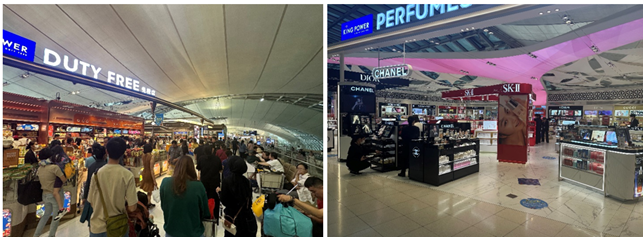Asian infrastructure - Trip insights with 4D Infrastructure (part 2)
This is part two in a four-part series from our recent trip through Asia. Part one is available below:

Infrastructure
While much is happening across the Asian infrastructure landscape, this trip really highlighted and reinforced some strong thematic, including:
- Passenger travel: Despite global affordability issues, travel momentum remains strong, even with a slower Chinese recovery. This appears to be partly structural, but even if not, we see positive ongoing passenger and earnings momentum through at least 2024 which we continue to capitalise on.
- Ports: Volumes certainly reflective of the softening of global demand and increased geopolitical conflict but Asian players are well positioned and attractively valued, albeit with absence of near-term organic catalysts.
- Energy: The Energy Transition is a theme in the emerging world just as it is in the developed world with significant discussion on how corporates can capitalise on it, the shift from coal to gas, how waste to energy can play a part, long term investment requirements and who pays for it. These discussions included M&A opportunities versus organic growth potential as well as the impact of recent falls in commodity prices.
- Communications: The rise of data is another global infrastructure thematic. Who, how and when this theme can be captured was an interesting discussion.
- Management strength: A key takeaway from this trip was the relative strength of various management teams – those capitalising on the opportunities afforded to them whilst cognisant of investor concerns/demands, versus those that seemed to execute without consideration of shareholder interests. This theme saw us exit positions while reinforcing commitment to others.
We touch on each of these across this series, as well as wrap up a few other sector dynamics.
Airports
Traffic recovery supported by policy and demand
The global air passenger traffic volume in 2023 was at 94% of 2019 levels, with domestic traffic at 104% and international traffic at 88% of pre-pandemic levels[1]. The Asia-Pacific region continued to lag with the overall recovery rate at 86%, with domestic at 102% and international at 73%. While there has been a swift rebound in domestic tourism, international tourism was tepid largely due to the notable absence of Chinese tourists. Unsurprisingly, Chinese outbound tourism had been weak given the country’s complicated and delayed reopening, weak consumer spending, lengthy visa and passport processing times, and reduced airline capacity.
However, in 2024, China's outbound tourism sector has seen a resurgence. Projections from Dragon Trail International[2] suggest that China’s outbound tourism is expected to reach approximately 80% of pre-pandemic levels by the end of this year (compared with 48%[3] in 2023), with a full return to pre-pandemic levels expected by the end of 2025. Ongoing post-pandemic traffic momentum was confirmed by management teams. Malaysia Airports (MAHB) expects monthly international passenger traffic recovery to exceed 90% in the first half of 2024, ultimately surpassing 2019 levels by the end of the year. Similarly, Airports of Thailand (AOT) are guiding for total passenger traffic across its network to recover to 85% in 2024 and exceed pre-pandemic levels by mid to late 2025.
Visa-free initiatives introduced in recent months have significantly contributed to the recovery in China’s outbound tourism. Most Chinese tourists are traveling to ASEAN countries, with the top destinations including Thailand, Singapore, Malaysia, Vietnam, and Indonesia. Additionally, Asian markets currency devaluation has played a large role in determining travel tendencies. Outside of ASEAN, popular destinations are the United States, the United Kingdom, South Korea, Japan, and Australia. This resurgence of Chinese tourism is expected to further boost international passenger traffic in the Asia-Pacific region and globally, accelerating the recovery of the broader tourism and aviation sectors.
Passenger recovery to support non-aeronautical earnings
During the pandemic, non-aeronautical revenues were negatively affected due to muted passenger throughput and abatements or incentives offered to retail partners. For example, AOT renegotiated the minimum rental guarantees with its duty-free concessionaire, King Power, in exchange for a higher revenue share. Likewise, MAHB waived the minimum guaranteed payment requirements to support retail tenants. Importantly, non-aeronautical spend (retail, food & beverage, and services) has correlated with the resurgence in passenger recovery and also benefited from the removal of abatements. Retail utilisation levels have increased from pandemic lows to in excess of 85%. Management teams anticipate this trend to continue towards the long-term optimal utilisation level of approximately 95%.
Historically, the average spend per basket of goods in Malaysia was around RM230, but since COVID this has increased to approximately RM330. Management highlighted that the changing product mix has been a key driver of this growth, along with higher inflation, which has also contributed to the increase in headline sales. AOT have minimum revenue guarantees with King Power, ranging from Bt7 to Bt233 per international passenger, depending on the airport. The collective revenue per international passenger across AOT's portfolio peaked at Bt218 before the pandemic. When passenger spending exceeds the minimum guarantee at each airport, AOT is entitled to a revenue share. To boost revenue, AOT is working closely with King Power to improve spending by diversifying product offerings and exploring strategies to convert terminal dwell times into spend. AOT noted the increasing preference among travellers for local and specialty stores over traditional big brand names and luxury goods.

The recovery in Chinese tourism is also set to significantly boost non-aeronautical revenues, as Chinese tourists notoriously rank among the highest travel spenders globally. According to UN Tourism statistics, Chinese tourists spent US$133.8 billion on outbound tourism in 2019, with a per capita consumption of US$863, ranking first in the world for outbound tourism expenditure and representing 23.8% of the global total. The potential for ongoing growth in Chinese outbound tourism is substantial, with the World Travel Market Global Travel forecasting that the value of China's outbound tourism will increase by 131% from 2024 to 2033. While in Europe, we have seen evidence of a pullback in Chinese spending this does not appear to be the case across Asia so far.
Regulation
MAHB has experienced a re-rating following the continued momentum behind its transition to a regulatory model. The recently signed Operating Agreement (18th March 2024) not only extends the airport network concession term by 35 years to 2069, but signifies a more comprehensive and dynamic approach to pricing mechanisms and investment.
Starting from Regulatory Period 2 (RP2) in 2027, Passenger Service Charges (PSC) will be determined using a building block model, moving away from the previous system of inflation indexation every five years. This new approach considers various factors such as operating costs, market demands, and broader industry dynamics, enabling a more comprehensive and dynamic pricing structure. The building block model allows for a more nuanced calculation of PSC, reflecting the actual costs and needs of operating an airport network. This includes considerations like capital expenditures for infrastructure development, operational expenses, and expected returns on investment. The flexibility inherent in this model provides MAHB with greater scope to adjust to changing market conditions, ensuring that the PSC accurately reflects the airport's financial requirements and economic environment. Management believes the company is currently under-earning compared to regulatory input methodologies and anticipates a material step-up in PSC charges under the framework.
AOT last raised passenger service charges in 2007, resulting in a 40% uptick to international passenger charges and a 50% increase to domestic charges. In 2013, AOT sought a further increase of 14% for international passengers, and a 50% increase for domestic passengers but this request was rejected by the Department of Civil Aviation (DCA). AOT plans to commence a further study on passenger service charges this year and are in the process of hiring an external consultant to assist. Management anticipates the study will take at least 12 months and will determine the quantum of increase to be sought. Once the study is completed, AOT will submit the findings to Civil Aviation Authority of Thailand (CAAT) and the Ministry of Transport (MOT). After their review, a formal submission will be made to the Cabinet for final approval. The entire process is expected to take at least 2-3 years, with no guarantee of a price increase, which is disappointing.
A key concern for AOT is the government's proposal to abolish duty-free on arrival. The proposal is still under consideration, with feedback being gathered from stakeholders like AOT, King Power, and the Ministry of Finance. Duty-free on arrival accounts for less than 10% of gross floor area (GFA) and less than 10% of concession revenues. AOT believes the move will not yield the desired effect of encouraging foreign tourists and returning Thai travellers to make more in-country purchases. They suggest that most passengers, whether foreign or Thai, tend to plan ahead and would duty-free shop on departure. While King Power, the duty-free concessionaire, could repurpose the floor space with different commercial activities, AOT anticipates that removing duty-free on arrival would lower revenue per passenger, affecting contractual obligations. If the policy proceeds, AOT might have to reduce the minimum guarantee per passenger, but this could be partially offset by higher revenue share arrangements.
M&A
MAHB has been the subject of potential takeover speculation following an article[4] published in The Edge Malaysia Weekly on the 24th of February, 2024. The article suggests that the company’s major shareholders Khazanah Nasional (33.24%) and Employees Provident Fund (6.07%) are looking to formulate a strategic partnership with Global Infrastructure Partners (GIP) to operate Malaysia Airports. The article does not specify whether this partnership would involve equity participation from GIP, a secondary placement of shares from Khazanah & EPF to GIP or a consortium-led privatisation. Given the airport network would be considered national assets, a 51% holding by government and/or domestic nationals would be required.
We do not see the timing of news as coincidental given MAHB's transition to a regulatory model and its strong underlying value. According to FactSet consensus data, MAHB remains one of the most attractively valued listed airports, with a forward EV/EBITDA of 7.5x compared to the sector average of 11x. GIP, with its extensive experience in global airport management, could help to improve operations and bring significant financial capacity, supporting the funding requirements for Malaysia's extensive airport network.
Potential corporate actions present upside risk, but does not underpin our core investment thesis. We find MAHB offering solid value at current prices, with ongoing passenger recovery and a shift toward higher-yielding international traffic to drive earnings and distribution growth.
For more information, you can get in touch here.
[1] International Air Transport Association (IATA) 2023 report

